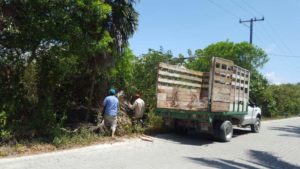
Cleaning-up North Akumal and the mangrove is sure no small task. Many have observed arm-loads of garden debris being carried across the road by workers.
-
Where are they going?
-
Is it a secret place where dead palm leaves get new life?
-
Is this a good thing to happen in North Akumal?
Well, “No!” came the resounding answer, and we’ll address the importance of mangroves in a minute. However, this practice of dumping garden trash into the mangrove has been going on for years and years—take a peek between lush plant life that borders the road and you will see the build-up in many places. True, not everyone in North Akumal does this—many call for specially hired dump trucks to load and haul their debris away to legal refuse places. Other communities in the Akumal-area may have their own plans to deal with garden trash, but logic says they, too, have been dumping into the mangrove.
Our wonderful climate produces plants and trees that grow rapidly—and these plants and trees must shed their leaves or be trimmed to be kept in prime order. The regular trash trucks from Tulum will not pick up garden refuse, so dumping into the mangrove became the standard.
Vecinos de Akumal Norte (the group representing owners) and ADMAK (the property managers group) decided to foster a clean-up in North Akumal. Information was sent to all owners to have their workers clean-out the refuse placed in the mangrove opposite their properties and to stack it near the road. Twenty-one homes/condos participated; the pre-paid cost of this participation was $800 pesos (that’s less than $50.00usd!); the money went to the cost of trucks and their loader/workers. If there are excess funds after the trucks have been paid, then money will be refunded to participants on an equal basis.
Although planned jointly, ADMAK took the lead with Claudia Flores and Sancho Ake organizing this first clean-up on May 23, 2016. ADMAK workers met early that morning at La Buena Vida Restaurant—each bringing his own machete, gloves, and trash bags, and they received their instructions. First, clean-up the road side trash and bag the debris–(which included lots of glass, aluminium, iron, wood—as well as a few weird things). These workers particularly attacked the vacant lots. These guys are to be commended for the excellent work done that day!
So—why is all of this important you ask? Searching the Web, I found many sites explaining the role of Mangroves (including great photos from National Geographic) and the significance to Mexico. Mexico is one of the countries with the most mangroves, yet it is also ranks as a leader in mangrove deforestation rate. Mangroves are trees that have evolved to survive in flooded coastal environments. The salt and lack of oxygen makes life impossible for other plants, but these trees offer shelter and food to numerous other plants, birds, reptiles, and animals. Plus mangroves provide shelter and food for the juveniles of the main fisheries species.
The Mexican coastline features more than 700,000 hectares of mangroves: 5% of the world total. The evolved tree roots are sunk firmly into the mud; they absorb 90% of the energy of the waves which make it a phenomenal detriment to the damages caused by hurricanes and other strong wind.
In addition to fostering life, the mangrove provides valuable ecosystem services. These services can reach an annual value of $100,000 USD per hectare, which means that every year Mexico’s mangroves contribute to the national economy with 70 billion dollars. Despite this widely recognized value of this national capital, Mexico has one of the highest deforestation rates in the world. Every year thousands of hectares are cleared and replaced by shrimp farms, agro-industrial plantations, or touristic mega-developments (to wit, early in 2016 the Malecon Tajamar project in Cancun destroyed 143 acres in order to build offices, apartments, shopping malls, and a huge church. Of course, activists protested the clearing and legal recourses are being pursued). If the current deforestation levels continue, in 25 years close to 50% of Mexican mangroves will have been lost. Mexican government officials are aware of the value of the 81 distinct areas, 25 of which are in the Yucatan Peninsula, and are at work to resolve issues.

So, back to question, “Why should mangroves be important to you?” Keeping our mangroves free of debris has increasing significance both nationally and locally. Once we understand the role played by mangroves, we can do our part to eliminate all the waste materials that have been dumped over the years and inform our guests and friends to also act accordingly.
The next major clean-up will be in October, 2016. Again, kudos to ADMAK and Vecinos for the marvellous results of this first undertaking!








Leave a Reply